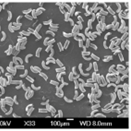Combinatorial Studies of Reactive Materials
The contribution of metal powders to propulsion, blast, and thermobaric effects relies on their ease of ignition and efficiency of combustion. However, there is still limited knowledge of the reactions that occur on the microsecond and millisecond timescales when metal powders ignite and combust in air, as well as the more complex, composite derivatives that arise. Of the metal powders commonly used in energetic formulations, Al and Mg combust primarily in the vapor phase by first evaporating and then oxidizing, while Ti and Zr combust in a condensed liquid or solid phase and are reactive with nitrogen, not just oxygen. We consider this type of reaction to be dual-phase combustion. Combining elements from these two groups can leverage both modes of combustion simultaneously to enhance burn rates and efficiencies for a given powder size.
We will use a combinatorial approach to sputter deposit and characterize alloyed powders across a broad range of chemistries, and we will characterize their properties by performing ignition and combustion tests at the millisecond timescale. Elements will be sputtered onto polymer mesh substrates to yield microscale powders for ignition and combustion studies as shown in the figure below. We will perform multiple depositions in which we vary the ratio of elements such as Al-B/Ti and Al-B/Zr powders.

We plan to fabricate the most promising chemistries via gas atomization. This technique can be used to develop core-shell geometries that may reduce or increase sensitivity to ignition thresholds. These can then be compared for size and microstructure of traditional ball-milled powders.
